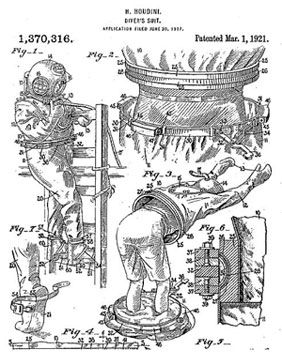 Harry Houdini was born in Budapest, Hungary, to a Jewish family. Houdini began his career as a trapeze artist and was later renowned as a magician and an escape artist. He astonished audiences by escaping from handcuffs, straitjackets, and prison cells.
Harry Houdini was born in Budapest, Hungary, to a Jewish family. Houdini began his career as a trapeze artist and was later renowned as a magician and an escape artist. He astonished audiences by escaping from handcuffs, straitjackets, and prison cells.
Houdini also held a patent for a style of diving suit. The innovation was granted U.S. Patent Number 1,370,316 on March 1, 1921. The object of Houdini’s diving suit was to allow a diver to get out of the suit while submerged. This helped the diver swiftly and safely escape and reach the surface of the water. It also allowed a diver to don his suit without assistance. This was accomplished by being formed in two halves, with a locking joint in the middle. The diver could reach this joint and release it, and then escape from the suit. Continue reading “Making History: Harry Houdini Patents a Diving Suit”

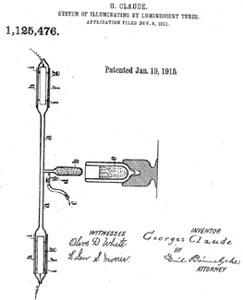 In 1915, a U.S. Patent No. 1,125,476 was issued to George Claude of Paris for a “System of Illuminating by Luminescent Tubes.” This patent was the basis for the neon sign. Claude, an engineer, chemist and inventor was the first person to create a lamp by applying an electrical discharge to a sealed tube of neon. By mixing other gases with the neon, Claude was able to produce the light in many different colors. He, also, discovered that the tubes holding the gas mixture could be bent and twisted. This allowed him to produce the letters and shapes that are the signature of a neon sign.
In 1915, a U.S. Patent No. 1,125,476 was issued to George Claude of Paris for a “System of Illuminating by Luminescent Tubes.” This patent was the basis for the neon sign. Claude, an engineer, chemist and inventor was the first person to create a lamp by applying an electrical discharge to a sealed tube of neon. By mixing other gases with the neon, Claude was able to produce the light in many different colors. He, also, discovered that the tubes holding the gas mixture could be bent and twisted. This allowed him to produce the letters and shapes that are the signature of a neon sign. On October 7, 1952 Bernard Silver and Norman Joseph Woodland received US Patent 2,612,994 for “Classifying Apparatus and Method.”
On October 7, 1952 Bernard Silver and Norman Joseph Woodland received US Patent 2,612,994 for “Classifying Apparatus and Method.”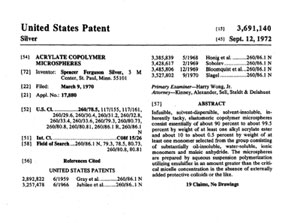 Sometimes an inventor will make a best selling product completely be accident. The Post It Note is an example of that. In 1968, Dr. Spencer Silver invented a repositionable adhesive that was strong enough to stick to surfaces but did not leave any residue. Silver had not set out to produce such a glue. He was actually trying to make a very strong adhesive. Patent Number #3691140 for Acrylate Copolymer Microspheres, the adhesive used on Post It Notes was granted to Spencer Ferguson Silver on March 9, 1970. But 3M never utilized this adhesive.
Sometimes an inventor will make a best selling product completely be accident. The Post It Note is an example of that. In 1968, Dr. Spencer Silver invented a repositionable adhesive that was strong enough to stick to surfaces but did not leave any residue. Silver had not set out to produce such a glue. He was actually trying to make a very strong adhesive. Patent Number #3691140 for Acrylate Copolymer Microspheres, the adhesive used on Post It Notes was granted to Spencer Ferguson Silver on March 9, 1970. But 3M never utilized this adhesive. 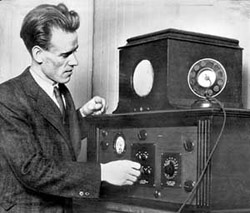 Philo Taylor Farnsworth was an American inventor born August 19, 1906. He was best known for inventing the first fully electronic television system, including the first working electronic image pickup device (video camera tube), and for being the first to demonstrate fully electronic television to the public.
Philo Taylor Farnsworth was an American inventor born August 19, 1906. He was best known for inventing the first fully electronic television system, including the first working electronic image pickup device (video camera tube), and for being the first to demonstrate fully electronic television to the public.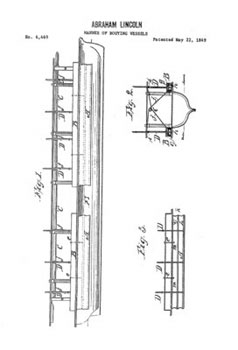 Abraham Lincoln received patent #6469 on May 22, 1849 for a device to lift boats over shoals. His device was never manufactured but he did become the only president to hold a patent.
Abraham Lincoln received patent #6469 on May 22, 1849 for a device to lift boats over shoals. His device was never manufactured but he did become the only president to hold a patent.